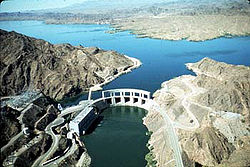Parker Dam's primary purpose is to provide reservoir storage from which water can be pumped into the Colorado River (California) and Central Arizona Project Aqueducts. Lake Havasu, the reservoir behind Parker Dam, is about 45 miles long and covers nearly 20,390 acres. It can store 648,000 acre-feet or nearly 211 billion gallons of water.
 Parker Dam spans the Colorado River between Arizona and California, 155 miles downstream from Hoover Dam. Built between 1934 and 1938 by the Bureau of Reclamation, Parker Dam is operated with Hoover and Davis Dams to bring water and power benefits to residents of the lower Colorado River Basin. Parker Dam spans the Colorado River between Arizona and California, 155 miles downstream from Hoover Dam. Built between 1934 and 1938 by the Bureau of Reclamation, Parker Dam is operated with Hoover and Davis Dams to bring water and power benefits to residents of the lower Colorado River Basin.
Parker Dam's primary purpose is to provide reservoir storage for water to be pumped into the Colorado River and Central Arizona Project Aqueducts. Lake Havasu, the reservoir behind Parker Dam, is about 45 miles long and can store nearly 211 billion gallons of water.
Lake Havasu provides clear, desilted water for the Colorado River Aqueduct and serves the Central Arizona Project. Parker Dam was constructed with funds advanced by the Metropolitan Water District of Southern California. Since 1941, the Colorado River Aqueduct has delivered water from Lake Havasu behind Parker Dam to the Los Angeles metropolitan area. The Colorado River Aqueduct is also tapped by the San Diego Aqueduct, which takes water to that city's water system as well.
Parker Dam is the deepest dam in the world; 73 percent of its structural height of 320 feet is below the original riverbed. Two-hundred and thirty-five feet of the Colorado riverbed was excavated before concrete was placed for the dam's foundation. Only about 85 feet of the dam is visible; the dam's superstructure rises another 62 feet above the roadway across the top of the dam.
Hydroelectric Power
Parker, Davis and Hoover Dams and their power plants are operated and managed by the U.S. Bureau of Reclamation from the Lower Colorado Dams Facilities Office at Hoover Dam. The Department of Energy, through the Western Area Power Administration, markets the hydropower produced by these three power plants to cities, agricultural users and Native American communities throughout the Southwest.
Parker power plant, located on the California side of the Colorado River immediately below the dam, houses four hydroelectric generating units. Each unit can produce 30,000 kilowatts of non-polluting hydroelectric power. Four 22-foot-diameter pipes called penstocks can each carry up to 5500 cubic feet of water per second (over 41,000 gallons) to feed the generating units. About 50 percent of the plant's power output is reserved by the Metropolitan Water District of Southern California (MWD) for pumping water through the Colorado River Aqueduct to the Pacific Coast. The remaining power is marketed by the Western Area Power Administration.
Under an agreement between Reclamation and MWD, the latter agency paid essentially the entire cost of constructing Parker Dam. MWD's Whitsett Pumping Plant, 2 miles upstream from the dam on Lake Havasu, lifts water from the reservoir into the Colorado River Aqueduct.
Colorado River water is delivered to users by pumping it from Lake Havasu into the conveyance system, then relifting it through a series of pumping plants across the state. From Lake Havasu to the end of the aqueduct, the water will be lifted nearly 2,900 feet in elevation. Havasu, the project's largest pumping plant, lifts the water from Lake Havasu to the Buckskin Mountains Tunnel inlet 824 feet above the lake's surface. The water then flows seven miles through the tunnel to the first section of canal.
Lake Havasu, the southernmost of four large reservoirs on the Colorado River in Arizona, was formed in 1938 by completion of Parker Dam |